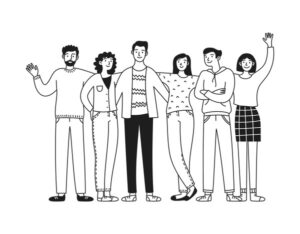Youth may act as a bridge between traditional and modern practices for sustainable living
Introduction:
In 2050, the world’s population will reach 10 billion. This vast population will require more food, clothing, accommodation, and also produce more carbon dioxide. The world’s ecology has already been suffering due to pollution and global warming. The increasing population and the continued use of natural resources may further disrupt the climate and global ecology. Even climate change is not a concern for the future but a pressing issue affecting people today.
By adopting sustainable life practices, we can reduce the environmental and climate impact. young people can contribute to a sustainable world by blending traditional practices with modern lifestyles, finding a balance between the two.
Reduce waste water and food
In traditional life, people used pond water and river water for bathing, washing clothes, and other purposes. It was a sustainable practice for water usage and relied on surface water sources. However, in modern urban life, we rely on water from tanks that draw from underground sources. This has led to the depletion of groundwater, resulting in drought conditions for farming and hindering the growth of natural trees. Therefore, promoting the sustainable use of water in urban bathrooms and reducing water consumption during activities like bathing, clothes washing, and shaving can contribute to climate action.
Wasting food is another detrimental habit, especially in urban areas, particularly in restaurants. Every stage of food production requires water and involves various related issues. As the world grapples with meeting the food demands of its population, wasting food becomes a devastating issue. If you have the means, you should not waste food, as food is not solely about money; it is about sustaining life.
Alternative of Single-use plastics
One of the concerning issues in climate impact is the use of single-use plastics. Worldwide, five trillion plastic bags are used every year, with a significant portion of these being single-use plastics. Depending on the material, these plastics can take anywhere from 20 to 500 years to decompose in the soil. Single-use plastics disrupt soil fertility when they are discarded into the ground. Due to the lack of environmentally friendly waste management, many of these plastics find their way into the oceans, severely affecting marine biodiversity.
Therefore, adopting alternatives to single-use plastics, such as using tiny clay cups instead of plastic coffee or tea cups, can lead to a more sustainable lifestyle. In the United States alone, approximately 50 billion water bottles are purchased each year, averaging about 13 bottles per month for every person. By opting for reusable water bottles, you could save an average of 156 plastic bottles annually. This shift away from single-use plastic bottles for water can significantly reduce plastic pollution in both soil and marine environments.
Another major contributor to plastic pollution is packaging. Often, we tend to use excessive plastic bags or packaging unnecessarily, sometimes driven by fashion trends. However, the more packaging we use, the more plastic waste is generated, which harms the environment. Instead of relying on plastic bags for our daily shopping needs, we can make a conscious choice to use sustainable cloth bags or jute bags. As an alternative to single-use plastic plates, we can opt for more environmentally friendly options such as banana leaves or plates made from sturdy paper materials. This shift towards sustainable and eco-friendly bags can significantly contribute to reducing our plastic consumption and promote the use of environmentally friendly alternatives.
Escape from Fast Fashion
Adopting the use of reusable water bottles, bags, and avoiding single-use plastics in daily fashion choices can contribute to a sustainable lifestyle. However, another challenge to the environment is that urban life is highly fashion-oriented, and the youth in urban areas rapidly embrace new fashion trends, leading to increased clothing consumption. Fast fashion has resulted in approximately 80 billion to 150 billion clothing items being consumed annually.
Polyester and cotton are the most commonly used materials in clothing. Cotton is a highly resource-intensive crop, while polyester fibres are derived from coal, petroleum, air, and water. Decomposing clothing can release pollutants into the air and soil, impacting both groundwater and surface water quality. Ten percent of global greenhouse gas emissions come from the fashion industry.
Therefore, clothing production has a significant environmental impact. Thus, distancing ourselves from the fast fashion trend can contribute to sustainable living.
Reduce the Extra electricity use
31% of greenhouse gas emissions come from electricity and heat production. In modern life, people tend to use more lights, fans, air conditioners, refrigerators, and other electronic appliances for a luxurious lifestyle. However, using natural daylight can reduce the necessity for additional lighting. Additionally, sometimes utilizing natural ventilation can reduce the need for fans. In such way, avoiding unnecessary electricity consumption can contribute to sustainable living.
Sustainable Transport
15% of greenhouse gas emissions worldwide are attributed to transportation. Incorporating sustainable transportation methods into daily life is essential, as an alternative to fuel transportation. Using bicycles for daily transportation and walking shorter distances can contribute to the environment. Such practices not only benefit the environment but also ensure better health. Therefore, adopting sustainable transportation is another valuable strategy for achieving sustainable living.
Spirituality beliefs
Spirituality belief can also contribute to sustainable living. Buddha’s quote, ‘Sabbe Satta Bhavantu Sukhitatta’ (May all beings be happy), is influential in promoting a sustainable environment. Therefore, it can instil a sense of compassion and encourage individuals to consider the well-being of others, as well as the importance of trees and wildlife, which can ultimately lead to a sustainable future.
Consensus and education
Consensus and education are more important to promote sustainable living. Many people don’t have an idea of how they are affecting the environment in their daily lives and the ways of sustainable living. Therefore, a global campaign and consensus can bridge



